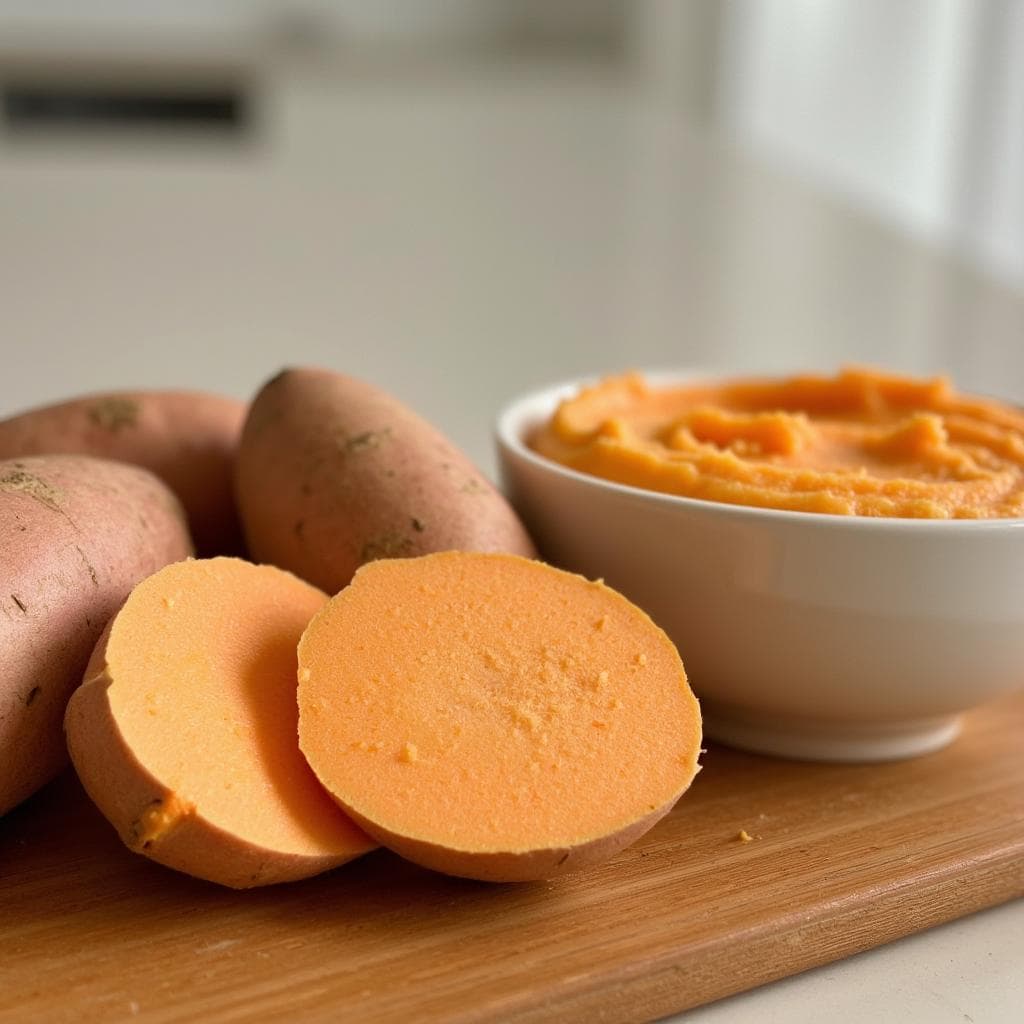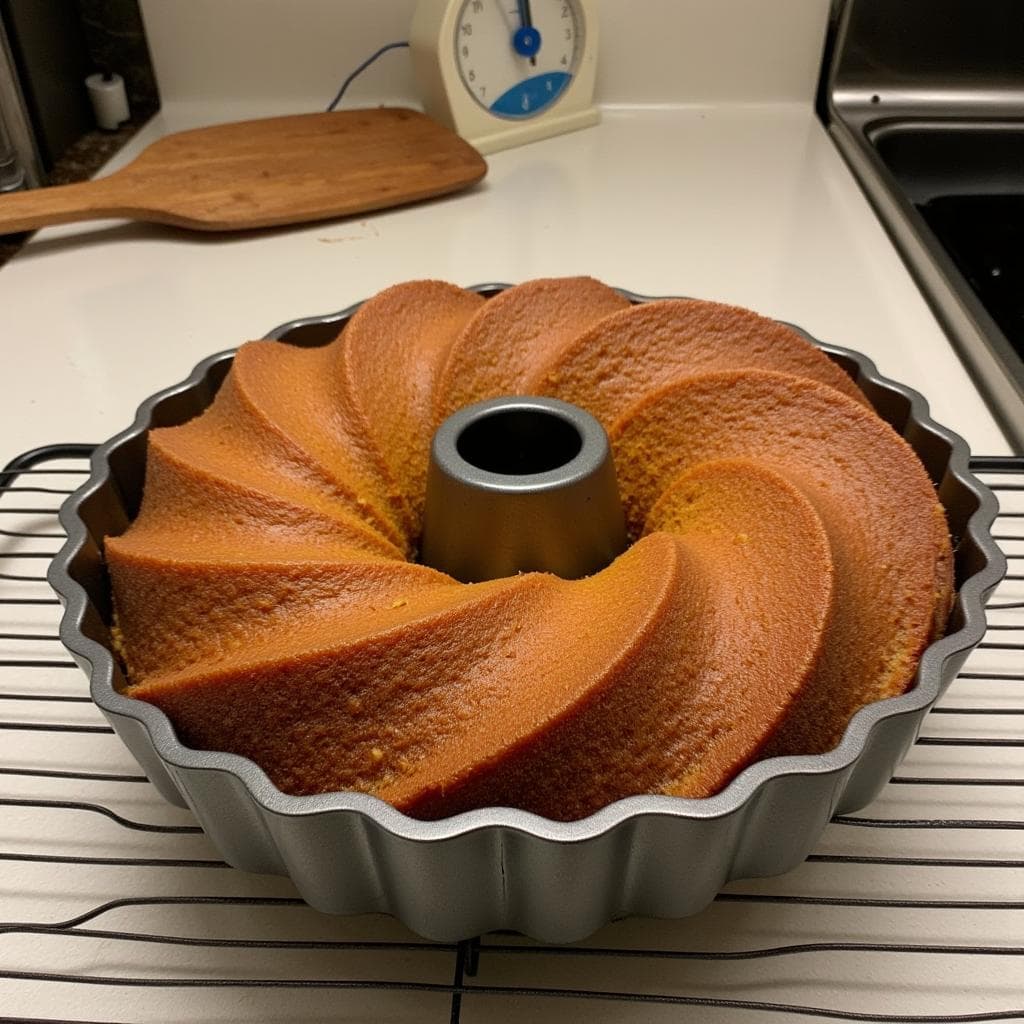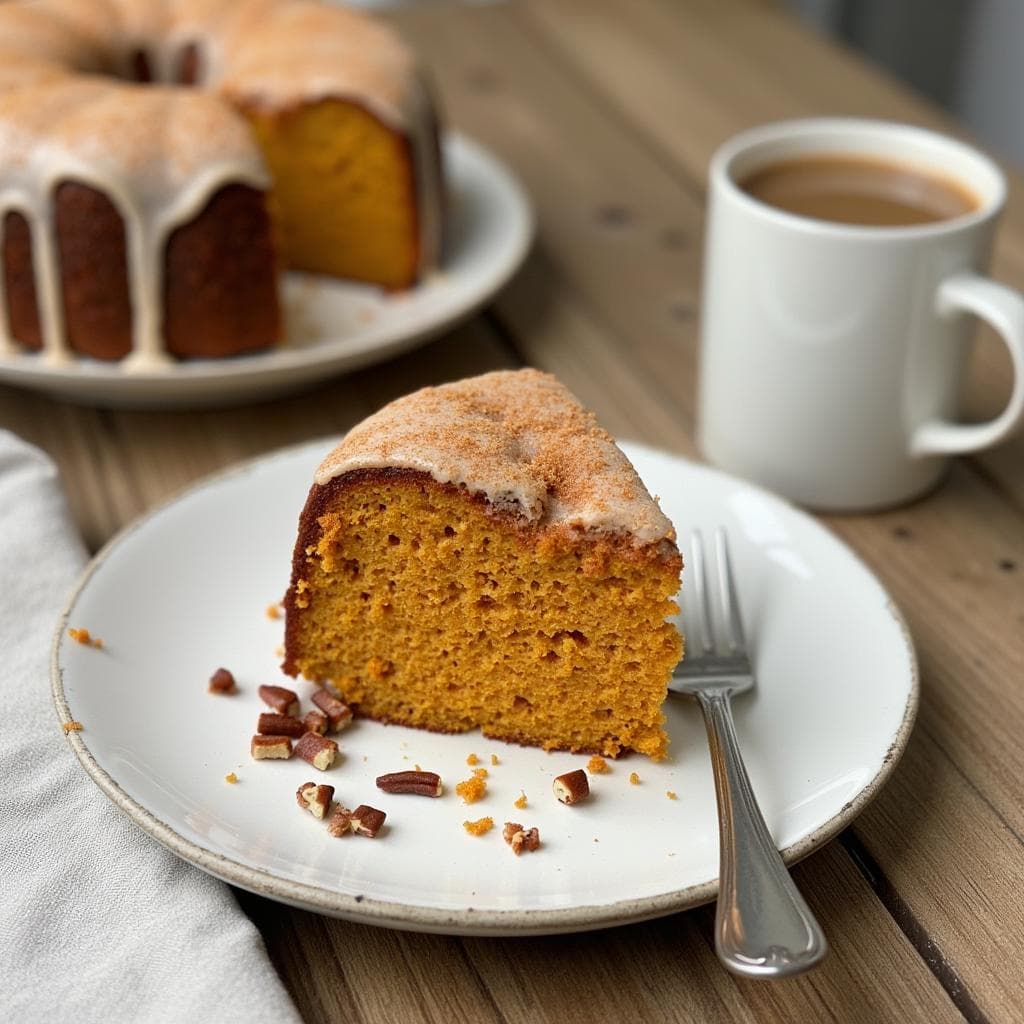If you appreciate a homemade dessert with deep flavors and moist texture, then a sweet potato pound cake might become your new favorite treat. This cake offers a rich taste, a delightful crumb, and a hint of classic holiday warmth. Though many associate it with special occasions, it can also work as a cozy everyday delight. The natural sweetness of sweet potatoes blends perfectly with butter, sugar, and warm spices. Therefore, you can bring comfort and joy to any table with this unique cake.
Why Sweet Potato Pound Cake Deserves a Spot on Your Table
In many families, sweet potato pound cake is a cherished recipe passed down through generations. It has a subtle sweetness, paired with a buttery richness that never fails to impress. The earthy sweetness of roasted sweet potatoes takes center stage. With every forkful, you experience a smooth crumb and mellow spice notes. This cake also adapts well to various occasions. For example, serve it during the holidays, bring it to a neighbor’s potluck, or slice it up for a quiet weekend afternoon.
In contrast to lighter cakes, this pound cake benefits from a dense yet moist texture. However, it never feels heavy or unbalanced. The sweet potato puree adds moisture and a gentle creaminess. When topped with a light glaze or dusted with powdered sugar, the flavors shine brightly without tasting too sweet. If you love a cake that looks elegant while tasting comforting, then this dessert may be what you are looking for.
Selecting and Preparing Sweet Potatoes for the Perfect Sweet Potato Pound Cake

To make a sweet potato pound cake worthy of praise, start with the right sweet potatoes. Choose medium-sized, fresh, and firm sweet potatoes with smooth skins. Avoid any with soft spots or mold. Opt for those with deep orange flesh, as they typically provide richer flavor and color.
Steps to Prepare Your Sweet Potatoes for Sweet Potato Pound Cake
- Washing: Rinse the sweet potatoes under cool water. Gently scrub off any dirt.
- Roasting or Boiling:
- Roasting: Place whole sweet potatoes on a baking sheet. Bake at 400°F (204°C) until soft, about 40-50 minutes. This method adds a caramelized sweetness.
- Boiling: Peel and chop sweet potatoes into chunks. Boil until tender. Drain and mash.
- Mashing: Once soft, mash the flesh until smooth. Remove any strings or lumps.
- Measuring: For most recipes, you need about one cup of mashed sweet potato for each standard-sized pound cake.
By following these steps, you get a creamy, flavorful base. Your final cake will have the perfect consistency.
Key Ingredients for a Moist and Rich Sweet Potato Pound Cake
While sweet potatoes play a starring role, other ingredients also matter. Consider these essential components:
- Butter: Use high-quality unsalted butter for a rich flavor. Softened butter whips better with sugar.
- Sugar: Granulated sugar provides sweetness and structure. Some bakers add a bit of brown sugar for depth.
- Eggs: Large eggs add richness and bind the batter. They contribute moisture and help with structure.
- Flour: All-purpose flour works well. Sift the flour to avoid lumps.
- Leavening: Baking powder helps the cake rise slightly. Pound cakes are dense, but a small lift improves the crumb.
- Spices: Cinnamon, nutmeg, and a hint of ginger pair well with sweet potatoes. Adjust to your taste.
- Milk or Buttermilk: Adds subtle tang and moisture. This helps create that tender crumb every baker loves.
By combining these ingredients thoughtfully, you allow the natural flavors of sweet potatoes to shine. The resulting cake will feel moist and comforting.
Tips for Mixing and Baking the Perfect Sweet Potato Pound Cake Batter
When making a sweet potato pound cake, proper mixing can make a huge difference. Consider these tips:
- Room Temperature Ingredients: Butter, eggs, and dairy should all be at room temperature. This helps them blend smoothly.
- Creaming Butter and Sugar: Beat butter and sugar until light and fluffy. This step creates tiny air pockets that lighten the texture.
- Adding Eggs One at a Time: Add each egg slowly, mixing well before the next. Scrape down the sides to incorporate every bit.
- Alternating Dry and Wet Ingredients: Add flour and milk in small batches, mixing just until combined. Overmixing leads to a tougher cake.
- Folding in Mashed Sweet Potato: Stir in the sweet potato last. Mix just enough to distribute it evenly.
By following these steps, you enhance the cake’s final texture. These techniques help prevent dryness or gumminess.
Baking Time and Temperature for Sweet Potato Pound Cake
Pound cakes bake low and slow. For a sweet potato pound cake, set your oven to around 325°F (163°C). Bake for about 60-75 minutes, testing with a toothpick to check doneness. The toothpick should come out with a few moist crumbs, not wet batter. If the cake browns too quickly, tent with foil. Rotate the pan halfway through baking for even heat distribution.

Cooling, Glazing, and Serving Suggestions for Sweet Potato Pound Cake
After pulling the cake from the oven, let it rest in the pan for about 15 minutes. This prevents it from breaking apart while unmolding. Then, turn it out onto a wire rack to cool completely. Cutting it too soon can result in crumbling, so patience matters here.
Glaze and Toppings for Sweet Potato Pound Cake
While a sweet potato pound cake tastes wonderful on its own, a simple glaze can highlight its flavors. Whisk together powdered sugar, a splash of milk, and a pinch of cinnamon for a quick cinnamon glaze. Drizzle it over the cooled cake for a sweet, spicy finish. Garnish with chopped pecans for crunch or serve it with a dollop of whipped cream.
Serving Occasions for Sweet Potato Pound Cake
This cake pairs beautifully with coffee or tea. Serve it at brunch, afternoon gatherings, or as a holiday dessert centerpiece. In contrast to overly sugary cakes, it complements a broad range of palates. It also travels well, making it a great choice for potlucks, bake sales, or gifts.
Storage and Make-Ahead Tips for Sweet Potato Pound Cake
A sweet potato pound cake keeps well for several days. Store it in an airtight container at room temperature for up to three days. For longer storage, refrigerate it, covered, for up to a week. You can freeze slices wrapped in plastic and foil for up to three months. Thaw overnight in the fridge and bring to room temperature before serving.
Make-Ahead Options for Sweet Potato Pound Cake
- Advance Prep: Roast sweet potatoes a day ahead. Refrigerate the mashed pulp until ready.
- Freeze Unbaked Batter: In some cases, you can freeze the batter before baking. Thaw and bake as usual.
- Bake and Freeze: Bake the cake, cool it, and wrap tightly before freezing. This saves time before big events.
By planning ahead, you can have a slice of this comforting cake ready whenever you crave it.
Adding Variations to Your Sweet Potato Pound Cake
One of the best parts about this dessert is how flexible it can be. Although the classic recipe stands strong on its own, you can add subtle twists:
- Brown Sugar and Maple: Add a few tablespoons of brown sugar or a splash of maple syrup. This increases depth and flavor.
- Cream Cheese Filling: Spoon a layer of cream cheese mixture into the center of the batter. The creamy filling adds a tangy surprise.
- Citrus Zest: A bit of orange or lemon zest brightens the flavor. It pairs well with warm spices.
- Chocolate Chips: Fold in a handful of mini chocolate chips. Sweet potato and chocolate may sound unusual, but it works surprisingly well.
- Rum or Bourbon Glaze: A boozy glaze can add a grown-up twist. Use alcohol sparingly.
These variations keep your baking adventures interesting. They let you adapt the cake to your personal preferences.
Pairing Sweet Potato Pound Cake with Other Desserts and Dishes
While this cake shines on its own, consider pairing it with other dishes:
- Apple Crisp or Peach Cobbler: Offer a small slice of cake alongside a fruit dessert. This adds contrast and complexity.
- Ice Cream or Sorbet: A scoop of vanilla ice cream or fruity sorbet makes a wonderful accompaniment.
- Spiced Tea or Mulled Cider: Warm beverages with spices complement the cake’s flavors. Their aroma enhances the experience.
- Whipped Mascarpone: A dollop of lightly sweetened mascarpone cream highlights the cake’s richness.
By combining the cake with other treats, you create a dessert spread that caters to various tastes.
Cultural and Regional Roots of Sweet Potato Pound Cake
In some culinary traditions, sweet potatoes and warm spices feature prominently in desserts. This cake reflects those roots. Sweet potatoes have long been a staple in Southern cooking, and their natural sweetness fits well into baked goods. Many families developed their own versions of this dessert, passing it down as a comfort food that connects generations.
A sweet potato pound cake can appear at holiday tables, family reunions, and church gatherings. It often becomes part of cherished memories. Its presence on the table can spark conversations, stories, and warm feelings. It adapts to new interpretations while still retaining its essence.
Healthful Adjustments and Special Diet Considerations for Sweet Potato Pound Cake
While sweet potato pound cake includes butter and sugar, you can adjust the recipe to fit certain diets:
- Reduced Sugar: Use a sugar substitute or reduce sugar. Sweet potatoes offer natural sweetness.
- Gluten-Free Flour: Replace regular flour with a gluten-free blend. The texture might differ slightly, but it remains tasty.
- Dairy-Free Butter Substitute: Plant-based butter and dairy-free milk can work. Test small batches to find the best flavor.
- Egg Replacements: For those who avoid eggs, consider flax “eggs” or other suitable replacements. The result may be denser but still pleasing.
Consult reliable dietary guidelines to fit your personal needs. Although not a health food, this dessert can adapt to various lifestyles.
Avoiding Common Mistakes in Making Sweet Potato Pound Cake
While baking a sweet potato pound cake, pay attention to common pitfalls:
- Overmixing the Batter: This results in a tough cake. Mix only until combined.
- Underbaking or Overbaking: Check the cake around the 60-minute mark. A slightly moist crumb is perfect.
- Not Using Fresh Sweet Potatoes: Old or dried sweet potatoes lack flavor and moisture.
- Skipping the Cooling Period: Allow the cake to rest before slicing. This step keeps it from falling apart.
By watching for these issues, you set yourself up for success. Each slice will taste as wonderful as possible.
Baking a sweet potato pound cake can become a cherished tradition. Experiment with spices, glazes, and presentation. Involve loved ones in the process. Children can mash sweet potatoes, while older family members can share baking tips. Over time, the recipe may become your family’s hallmark dessert. It might even appear in scrapbooks, passed down through letters and stories.
When family members visit, welcome them with the smell of a freshly baked pound cake. Its aroma signals comfort and love. This dessert may transform from a mere recipe into a meaningful part of your culinary heritage.
Step-by-Step Recipe: Sweet Potato Pound Cake
Ingredients:
- 1 cup mashed cooked sweet potatoes (roasted or boiled)
- 3 cups all-purpose flour, sifted
- 2 teaspoons baking powder
- 1 teaspoon cinnamon
- 1/2 teaspoon nutmeg
- 1/4 teaspoon ginger
- 1/2 teaspoon salt
- 1 cup unsalted butter, softened
- 2 cups granulated sugar
- 4 large eggs, room temperature
- 1 cup milk or buttermilk, room temperature
- 1 teaspoon vanilla extract
Instructions:
- Preheat and Prepare: Preheat oven to 325°F (163°C). Grease and flour a 10-inch Bundt pan.
- Combine Dry Ingredients: In a bowl, whisk flour, baking powder, cinnamon, nutmeg, ginger, and salt.
- Cream Butter and Sugar: In a large mixing bowl, beat butter and sugar until light and fluffy, about 3-4 minutes.
- Add Eggs One by One: Add eggs, mixing well after each addition. Scrape down the bowl as needed.
- Add Dry and Wet Ingredients Alternately: Add flour mixture in three parts, alternating with milk. Mix just until combined.
- Fold in Sweet Potato and Vanilla: Gently stir in the mashed sweet potato and vanilla until smooth.
- Pour and Bake: Pour batter into prepared pan. Smooth the top. Bake for 60-75 minutes, or until a toothpick comes out clean or with moist crumbs.
- Cool and Unmold: Cool in the pan for 15 minutes. Turn out onto a wire rack to cool completely.
- Glaze (Optional): Mix powdered sugar, milk, and a pinch of cinnamon. Drizzle over cooled cake.
Serve and Enjoy: Slice the sweet potato pound cake and serve with coffee, whipped cream, or fresh berries.
Frequently Asked Questions
What makes a pound cake different from a regular cake?
A pound cake has a dense, moist texture. Traditionally, it used equal amounts of butter, sugar, eggs, and flour, giving it a buttery richness. It is heavier than a standard sponge or layer cake, yet still tender. While other cakes rely on whipped egg whites or chemical leaveners for lift, pound cakes remain dense and rich.
What is a pound of sweet potatoes?
A pound of sweet potatoes usually equals about two medium-sized sweet potatoes. However, the number may vary depending on size and density. When mashed, one pound of raw sweet potatoes often yields around one cup of puree. If a recipe asks for a pound, weigh them before cooking.
What causes a pound cake to be dry?
Dryness can occur if the batter is overmixed, the cake is overbaked, or the oven temperature is too high. Using less butter or sugar than the recipe suggests may also lead to dryness. Always measure ingredients accurately, and check the cake early to avoid dryness.
How do you keep pound cake moist?
To keep a pound cake moist, follow proper mixing techniques and bake at the correct temperature. Avoid overmixing the batter, and consider adding dairy like milk or buttermilk. Do not overbake; test for doneness with a toothpick. Storing the cake in an airtight container helps lock in moisture, while glazes and syrups add additional moisture.

